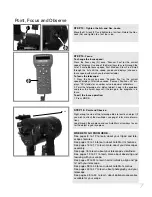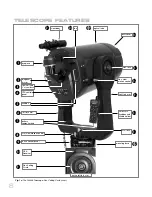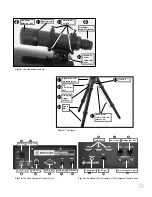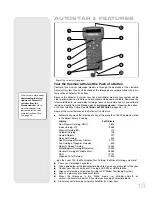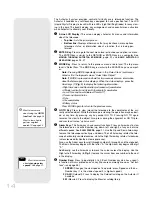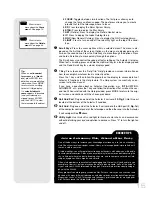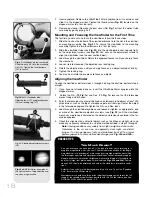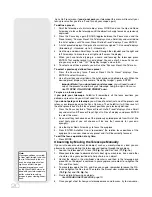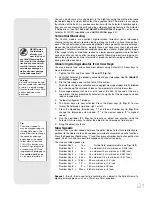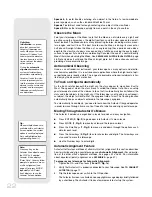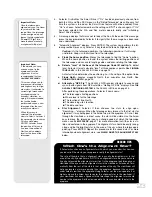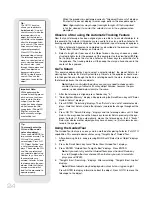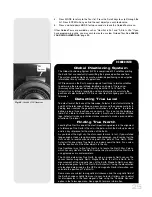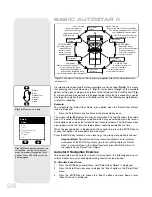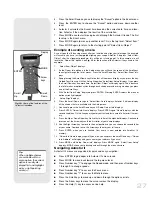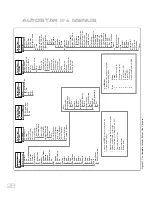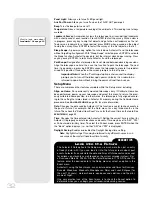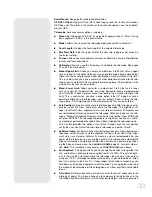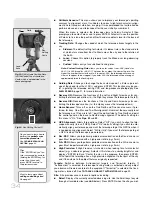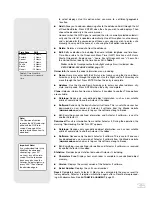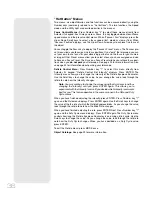
You can also observe stars and objects in the night sky using this method, but note
that objects begin to slowly drift across the eyepiece field. This motion is caused by
the rotation of the Earth. As you become familiar with the Autostar II handbox opera-
tion, you can counteract the drift using the automatic tracking feature in the Autostar
II Setup menu (see
TO TRACK AN OBJECT AUTOMATICALLY
, page 22), or by using
Autostar II's GO TO capabilities (see
GO TO SATURN
, page 24).
Terrestrial Observing
The
RCX400
models are excellent high-resolution terrestrial (land) telescopes.
Viewing terrestrial objects requires looking along the Earth's surface through heat
waves. These heat waves often cause degradation of image quality. Lower power eye-
pieces, like the UltraWide 24mm, magnify these heat waves less than higher power
eyepieces. Therefore, lower power eyepieces provide a steadier, higher quality image.
If the image is fuzzy or ill-defined, reduce to a lower power eyepiece, where the heat
waves do not have such an effect on image quality. Observing in early morning hours,
before the ground has built up internal heat, produces better viewing conditions than
during late afternoon hours.
Observing Using Autostar II's Arrow Keys
You may observe land and astronomical objects using Autostar II's Arrow keys to
move the telescope.
1.
Tighten the R.A. and Dec. locks (
13 and 17, Fig. 1a
).
2.
Verify that Autostar II is properly connected to your telescope. See
TO CONNECT
AUTOSTAR II
, page 17.
3.
Flip the telescope power switch to the ON position.
The Autostar II screen is activated and a copyright message displays briefly, followed
by a short beep. Then Autostar II takes a few moments to start up the system.
4.
A message displays that warns not to look at the Sun. At the end of this mes-
sage, press the key prompted by Autostar II to signify that the message has been
read and understood.
5.
"Automatic Alignment" displays.
6.
The Arrow keys are now activated. Press the Arrow keys (
5, Fig. 2
) to slew
(move) the telescope up, down, right, or left.
7.
Press the Speed key (Number key "1") and then a Number key (
6, Fig. 2
) to
change the telescope’s slew speed. ("1" is the slowest speed, "9" is highest
speed.)
8.
Use the viewfinder (
21, Fig. 1a
) to locate an object and practice using the
Autostar II’s Arrow keys to center the object in the telescope’s field of view.
9.
Bring the object into focus.
Slew Speeds
Autostar II has nine slew speeds that move the optical tube at rates that are directly pro-
portional to the sidereal rate and have been calculated to accomplish specific functions.
Press the Speed key (Number key "1") and then press a Number key to change the slew
speed, which is shown for about two seconds on Autostar II’s display.
The nine available speeds are:
Number Key 1 =
1x =
Guide Rate, programmable (see
Tip
at left)
Number Key 2 =
2x =
2 x sidereal (0.5 arc-min/sec or 0.008°/sec)
Number Key 3 =
8x =
8 x sidereal (2 arc-min/sec or 0.033°/sec)
Number Key 4 =
16x =
16 x sidereal (4 arc-min/sec or 0.067°/sec)
Number Key 5 =
64x =
64 x sidereal (16 arc-min/sec or 0.27°/sec)
Number Key 6 =
128x =
30 arc-min/sec or 0.5°/sec
Number Key 7 =
1.5° =
90 arc-min/sec or 1.5°/sec
Number Key 8 =
3° =
180 arc-min/sec or 3°/sec
Number Key 9 =
Max =
480 arc-min/sec or 8°/sec)
Speeds 1, 2, or 3:
Best used for fine centering of an object in the field of view of a
higher power eyepiece, such as a 12mm or a 9mm eyepiece.
Tip:
The slowest speed, 1x,
may be changed using the
Guiding Rate menu. This
menu allows you to change
the speed by entering a
percentage of the speed
(either more or less than
100%). This function may
be useful in guiding the tel-
escope during CCD and
long-exposure photography.
See
GUIDING RATE
, page
34, for more information.
NEVER point
the telescope
directly at or
near the Sun at
any time! Observing the
Sun, even for the smallest
fraction of a second, will
result in instant and irre-
versible eye damage, as
well as physical damage
to the telescope itself.
Warning:
Do not look through the tele-
scope's eyepiece or viewfind-
er while it is rapidly moving.
Children should always have
adult supervision while
observing.
21
Summary of Contents for RCX400
Page 73: ......

